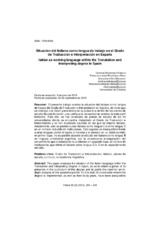Mostrar el registro sencillo del ítem
Situación del italiano como lengua de trabajo en el Grado de Traducción e Interpretación en España
| dc.contributor.author | Rodríguez-Faneca, Cristina | |
| dc.contributor.author | Rodríguez Mesa, Francisco José | |
| dc.contributor.author | Maz-Machado, Alexander | |
| dc.date.accessioned | 2020-02-06T13:11:52Z | |
| dc.date.available | 2020-02-06T13:11:52Z | |
| dc.date.issued | 2019 | |
| dc.identifier.issn | 1579-9794 | |
| dc.identifier.uri | http://hdl.handle.net/10396/19502 | |
| dc.description.abstract | El presente trabajo analiza la situación del italiano como lengua de trabajo del Grado de Traducción e Interpretación en España, de modo que se obtenga una visión panorámica de su presencia dentro de los planes de estudio de esta titulación y se justifique la necesidad de análisis de este perfil formativo. Para ello, se han analizado los planes de estudio de las 29 universidades donde se encuentra implantado el Grado de Traducción e Interpretación y se han localizado aquellas en las que se imparte italiano. Actualmente, solo es posible cursar italiano como lengua C o como lengua D en un número reducido de instituciones. Esto supone un desequilibrio frente a otras lenguas (como el inglés, el francés y el alemán) en un doble sentido: en primer lugar, no es posible acceder al estudio del italiano como lengua B en ninguna universidad española, con la consecuente jerarquización del conocimiento que el estudiante va a obtener; en segundo lugar, el número de instituciones que oferta el italiano como lengua C o D no es especialmente elevado. | es_ES |
| dc.description.abstract | This paper analyses the situation of the Italian language within the Translation and Interpreting Degree in Spain, so as to obtain a global of its presence in the curriculum of this degree and to justify the need for an indepth analysis of this academic profile. To this end, 29 universities where this degree is implemented, as well as their study plans, have been analysed to locate the ones where it is possible to learn Italian as part of a translation itinerary. It is only possible to study Italian as C or D Language in a reduced number of institutions. This implies an imbalance in relation to other languages (such as English, French or German) in a double sense. Firstly, it is not possible to study Italian as B Language in any Spanish university, with the consequent hierarchisation of the knowledge in certain languages that the student will find; secondly, the number of institutions offering Italian as C or D language is not particularly high. | es_ES |
| dc.format.mimetype | application/pdf | es_ES |
| dc.language.iso | spa | es_ES |
| dc.publisher | UCOPress | es_ES |
| dc.rights | https://creativecommons.org/licenses/by/4.0/ | es_ES |
| dc.source | Hikma 18(2), 301-329 (2019) | es_ES |
| dc.subject | Grado de Traducción e Interpretación | es_ES |
| dc.subject | italiano | es_ES |
| dc.subject | Planes de estudio | es_ES |
| dc.subject | Curriculo | es_ES |
| dc.subject | Competencia lingüistica | es_ES |
| dc.subject | Translation and Interpreting Degree | es_ES |
| dc.subject | Italian | es_ES |
| dc.subject | Study Plans | es_ES |
| dc.subject | Curriculum | es_ES |
| dc.subject | Linguistic Competence | es_ES |
| dc.title | Situación del italiano como lengua de trabajo en el Grado de Traducción e Interpretación en España | es_ES |
| dc.title.alternative | Italian as working language within the Translation and Interpreting degree in Spain | es_ES |
| dc.type | info:eu-repo/semantics/article | es_ES |
| dc.relation.publisherversion | https://www.uco.es/ucopress/ojs/index.php/hikma/index | es_ES |
| dc.rights.accessRights | info:eu-repo/semantics/openAccess | es_ES |

